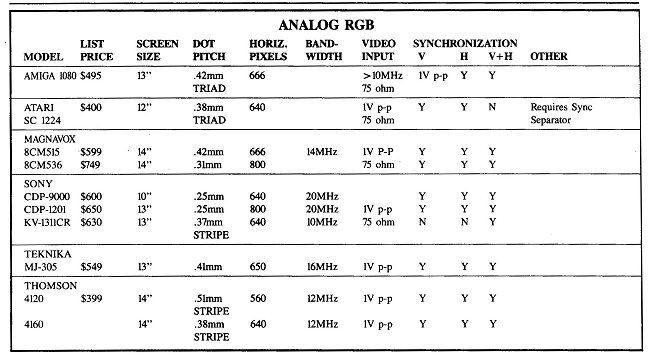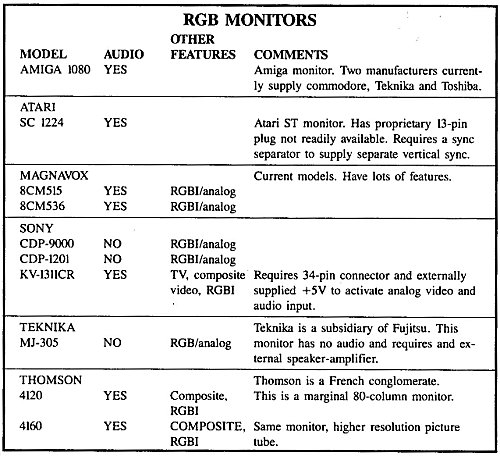Composite monitors and the TI
MicroPENDIUM March, 1989
By John Koloen
I was wrong about one thing in last month's installment about expanding your TI system: The TI Peripheral Expansion Box is not as noisy as a PC. With a whisper fan. installed, it is quieter than a PC. And another nice thing about the PEB is that it is not difficult to install a whisper fan in it. The same cannot be said for a PC, which integrates its cooling fan into its power supply.
This month's topic is about monitors. Specifically, composite color monitors for the TI. (Those with a Geneve or DIJIT Systems Advanced Video Processor Card, or other devices that allow the TI to use analog RGB monitors may refer to an article published in the March 1989 edition comparing various RGB monitors.)
Unlike PCs, MacintOshes and the Gen-eve, the TI console has its own video display processor. Thus the monitor plugs directly into the console and can be used without a Peripheral Expansion Box or other peripheral.
Selection of a composite monitor is based primarily on how much you want to spend. There are few other variables involved.
WHAT ABOUT MONOCHROME The only other monitor alternative you have with a basic TI is digital monochrome. Monochrome doesn't come highly recommended, though it can be used with a TI with good results. If most of your computing has to do with word processors, spread-sheets or similar text-oriented applications, then monochrome may serve you well. However, many programs for the TI -- particularly games -- are designed to use color, and they just don't look the same in monochrome. Incidentally, monochrome usually comes in green or amber.
COMPOSITE COLOR
What is a "composite" color monitor? The name comes from the way the monitor receives signals from the computer. With a composite monitor red, green and blue
are combined with synchronization pulses. Synch pulses create a stable image. Without them, the image would flutter.
As a rule, composite monitors are about double the price of normal monochrome monitors. Most come with built-in speakers and amplifiers. But don't assume that the monitor you select has a speaker. Many of them, particularly the lower end models, may not support sound. If you buy a monitor without a speaker you will have to jury-rig an external speaker to your TI. Otherwise your TI will produce no sound (except through the speech synthesizer, if you have one.) Remember, the TI console doesn't have a speaker.
COLORFUL BUT LOW-RES Specifications of composite monitors are not very important when it comes to the TI, or many other brands for that matter. Composite color is not comparable with the higher resolution possible with RGB color as used by the Geneve and the AVPC.
Once you've decided whether to go with monochrome or color, you'll need to decide on a vendor. If you go to a PC dealer, you are not likely to get much help when it comes to locating an appropriate cable.
Ironically, even though it is relatively easy to find the most expensive part -- the monitor -- finding the lowly and inexpensive cable can be a trial. Those who simply want to open the box and plug the monitor in will do best by buying from companies that support and sell TI products.
Those who are more adventurous can select a monitor from a local K-Mart or PC dealer and hunt up a cable at a Radio Shack or other electronic store. Larger cities often have electronic retailers and wholesalers that stock a bewildering array of equipment Jot products that are no longer manufactured. (You can locate them under "Electronics'' and "Electronics Equipment" listings in the phone book.) If this is the route you go, make sure you have the cable in hand before buying the monitor. Otherwise you'll get frustrated with the monitor sitting on the table and no cable to plug into it.
The third option with cables is to fabricate your own, or have a technician fabricate one for you. This isn't as difficult as it may sound, if you are handy with a soldering iron and have a basic understanding of electronics. Parts can be obtained from an electronics supply house. I have no experience at fabricating composite monitor cables, though I have built a cable for use with an RGB monitor. If you go the do-it-yourself route, check with Texas Instrument's technical experts at 806-741-2663 before starting out. However, as with all do-it-yourself projects, if you make your own cable, you are responsible for what it does or doesn't do. Wiring the power lead into the wrong position could short out your monitor and computer in an instant. If you aren't willing to take the responsibility you can have a local computer doctor fabricate it for you. It shouldn't cost more than $15-$20.
AFFORDABILITY
I've used a number of monitors with my TI, including those sold by Commodore for its computers, Magnavox, BMC, and TI's ' color 10-inch color monitor for the 4A. There isn't a whole lot of difference between them, in terms of color output. I like the 10-inch monitor because of its relatively compact size. Many of the composite moni- i tors have 14-inch screens and are quitel bulky. But many users prefer the large screens. It's a matter of taste.
You shouldn't expect to spend a lot on a monitor. A manufacturer's lower end models -- such as those by Magnavox -- will do just as well as their higher-priced models. What you are looking for primarily is a composite color monitor by a reputable manufacturer. It shouldn't be difficult to keep the cost under $200. (As an example, Tex-Comp recently advertised a composite color monitor by Magnavox for under $140.
Other advertisers have the TI 10-inch monitor available for $175. Regardless of what you buy, you want to reserve return privileges if the monitor proves to be unsatisfactory. The plain truth is that in most cases you will not be able to demo a monitor before buying it. When you buy one you are doing it on faith because until you actually plug it into your TI you will not be able to judge whether it is adequate to your needs.
WHAT ABOUT USED?
Used composite and monochrome monitors are in plentiful supply from a variety of sources, including Goodwill stores, pawn shops, flea markets, and computer repair businesses. If you can't afford a new monitor, or just like to shop for the best deal you can get, then check these places out. Even though the risk of getting a defective product is greater, the possiblity of obtaining a bargain to write home about is always there. For many, this may be the only way to get that TI disconnected from the TV and plugged into its own monitor. And believe me, it's worth it.
A comparison of selected
80-column analog RGB monitors
The following article was authored by Tom Spillane of DIJIT Systems, manufacturer of the RGB Conversion Kit. It is primarily of interest to those who want to convert their TI99/4A monitor output to RGB using the DIJIT Systems conversion kit and Geneve users who are interested in color monitors.--Ed.

High resolution analog RGB monitors have been used in industry for a number of years in computer aided design and professional graphics work stations that make those spectacular animated sequences seen on television. These monitors generally have 19-inch picture tubes and are capable of displaying up to 1280 x 1024 pixels. Their costs range upwards from $2,500.
The need for analog RGB monitors in the personal computer field has emerged in the last couple of years. The Amiga and Atari ST have brought with them scaled down graphics capabilities not unlike that of their more expensive cousins. The plethora of graphics cards for the IBM-PC type computer has given rise to the "multisync" monitors with both digital and analog RGB inputs. Even in the world of the TI-99/4A, the DIJIT Systems RGB Conversion Kit requires an analog RGB monitor to display the shades of color generated. And the AVPC as well as other V9988 based video cards require analog RGB monitors to display the palette of 512 colors they are capable of generating.
The accompanying chart was prepared as an aid in selecting an 80- column, analog RGB computer monitor. It omits two of the categories mentioned above, namely the industrial type, whose cost makes it inappropriate for the TI market (unless you can find a used or surplus one at a bargain price), and the "multisync" or "multiscan" types. A good review of the latter can be found in the February 1988 issue of Byte Magazine. The chart contains the best in-fomarion available to us and will be revised periodically. As you can see, there is not an extensive selection.

All of the below monitors comform to the EIA RS-343A standard requiring 0.7 volts p-p of video across 75 ohms input impedance. This signal level is the same as required by TV monitors and VCRs and is a worldwide standard. For simplicity we indicate I volt. The synchronizing signals required are combined (composite) horizontal and vertical sync having a negative sense at 0.3 volts p-p. They are on a line separate from the video.
Two factors affect resolution. They are the dot pitch of the physical pixels on the face of the picture tube and the video bandwidth. The coarsest dot pitch with which you can comfortably view 80-column text on a 14-inch diagonal screen is 0.42mm, making the Thomson 4120 a marginal 80-column performer. Ten megahertz is the minimum video bandwidth required to pass the high frequency components necessary for sharp edges on alpha-numeric characters. High quality monitors have a bandpass of 18MHz and up. In general, the higher the resolution, the higher the price. It all boils down to what you are comfortable with and what you are willing to pay. You are the final judge. The list prices shown are over a year old and are given for comparison only. Most monitors can be bought at substantial discounts by prudent buyers.
|



